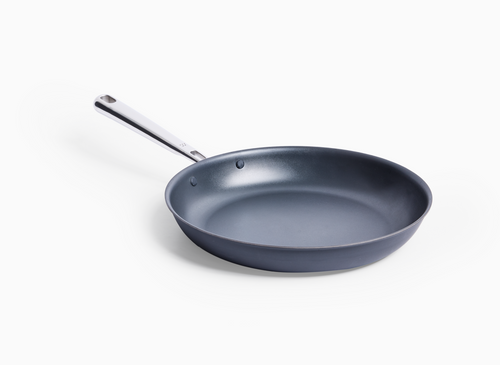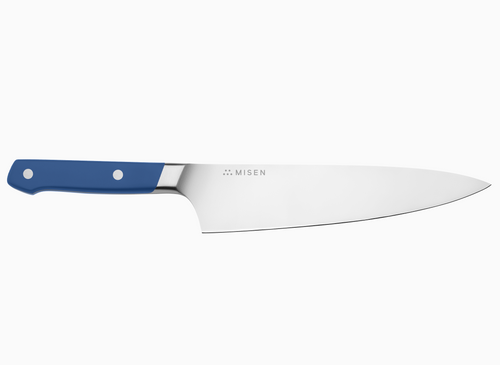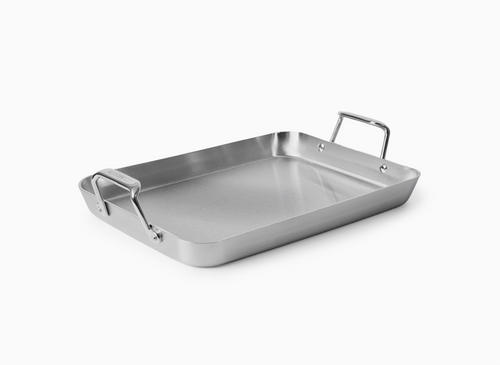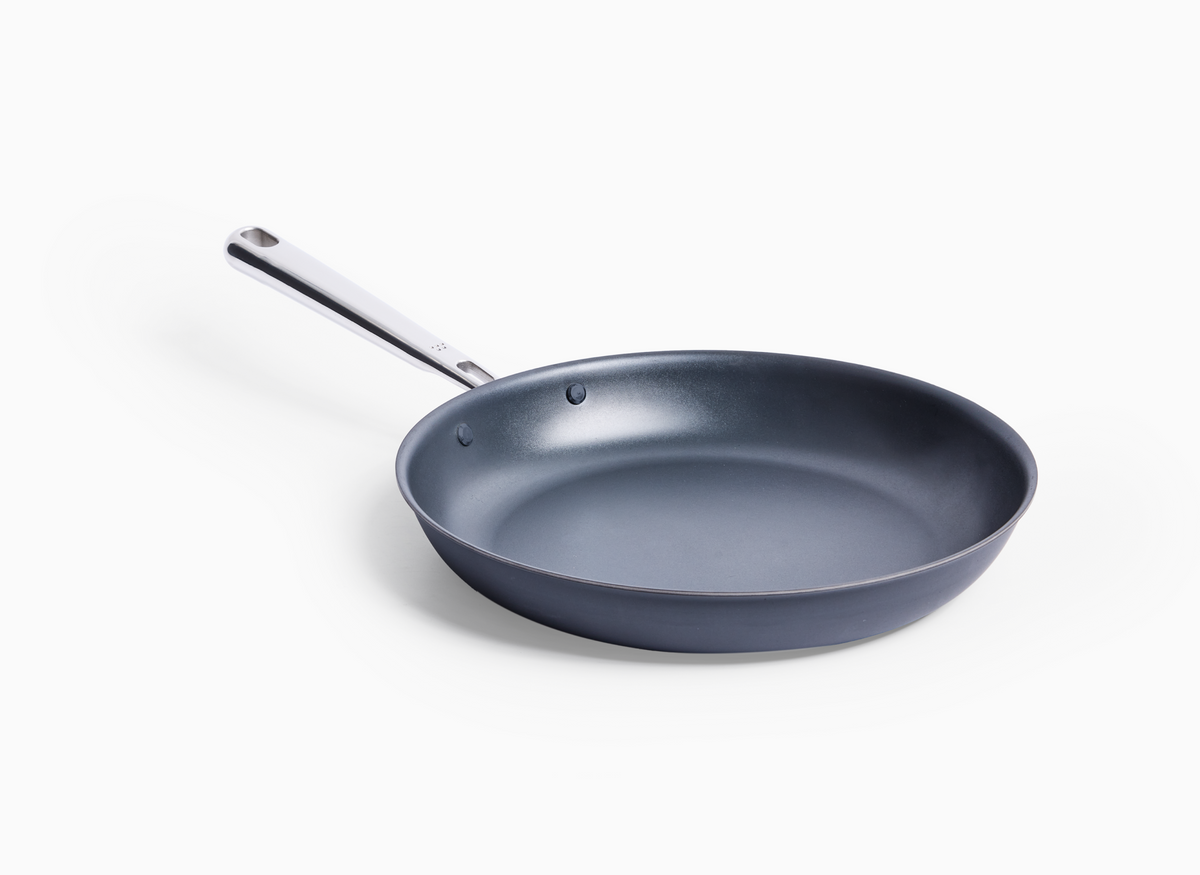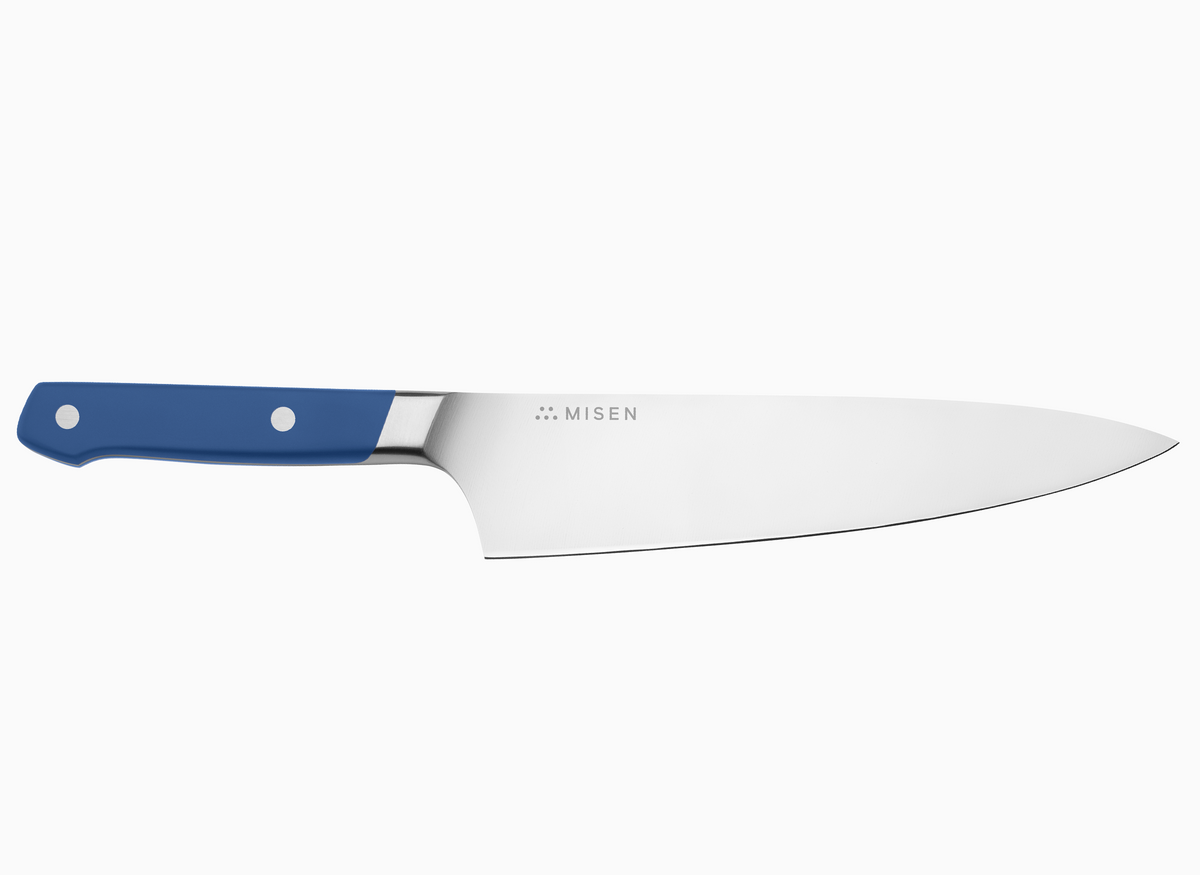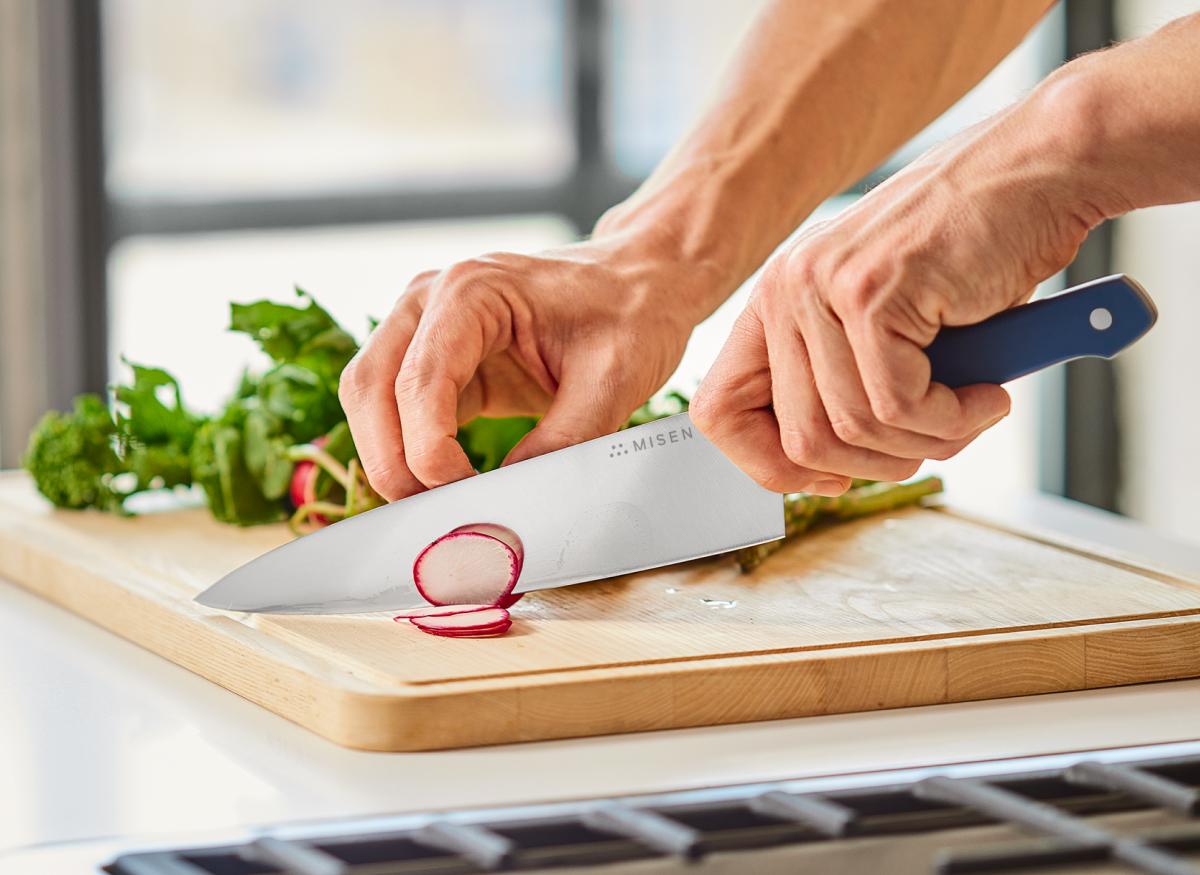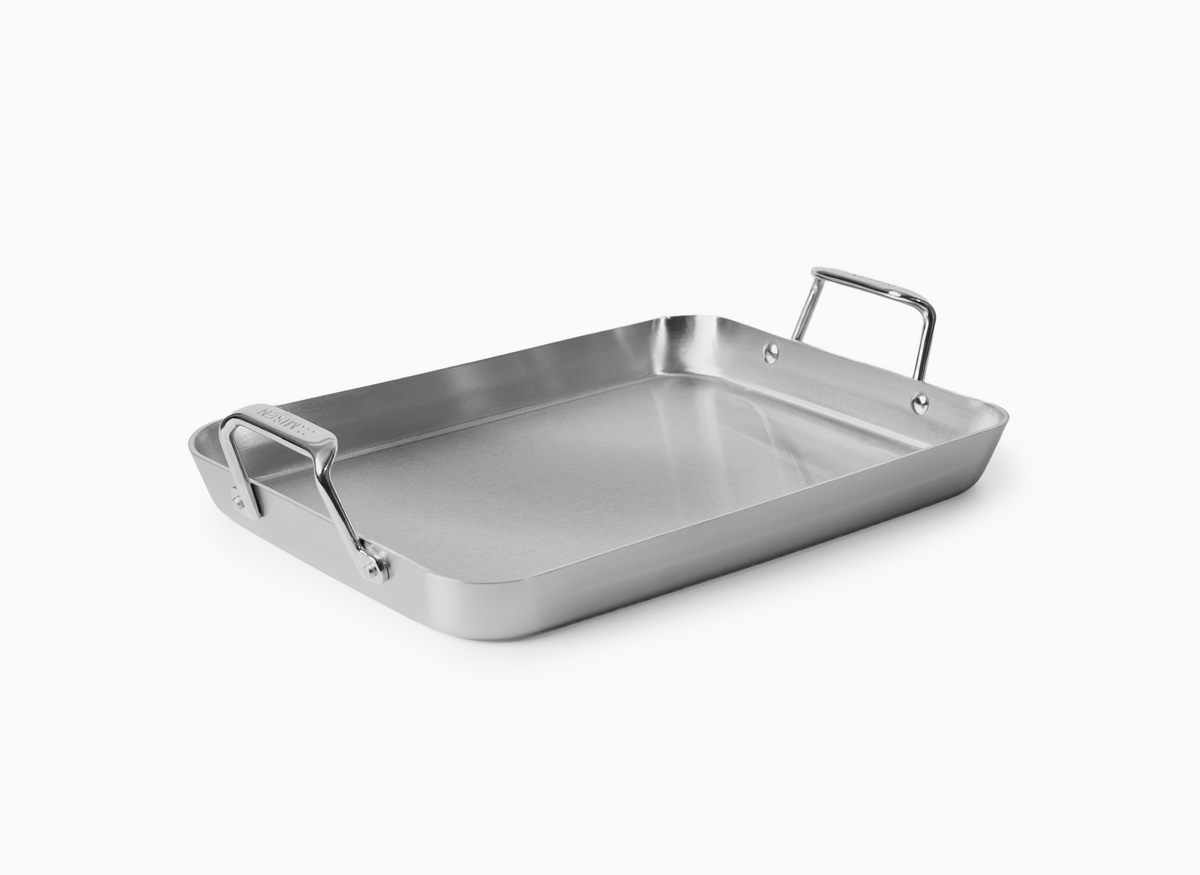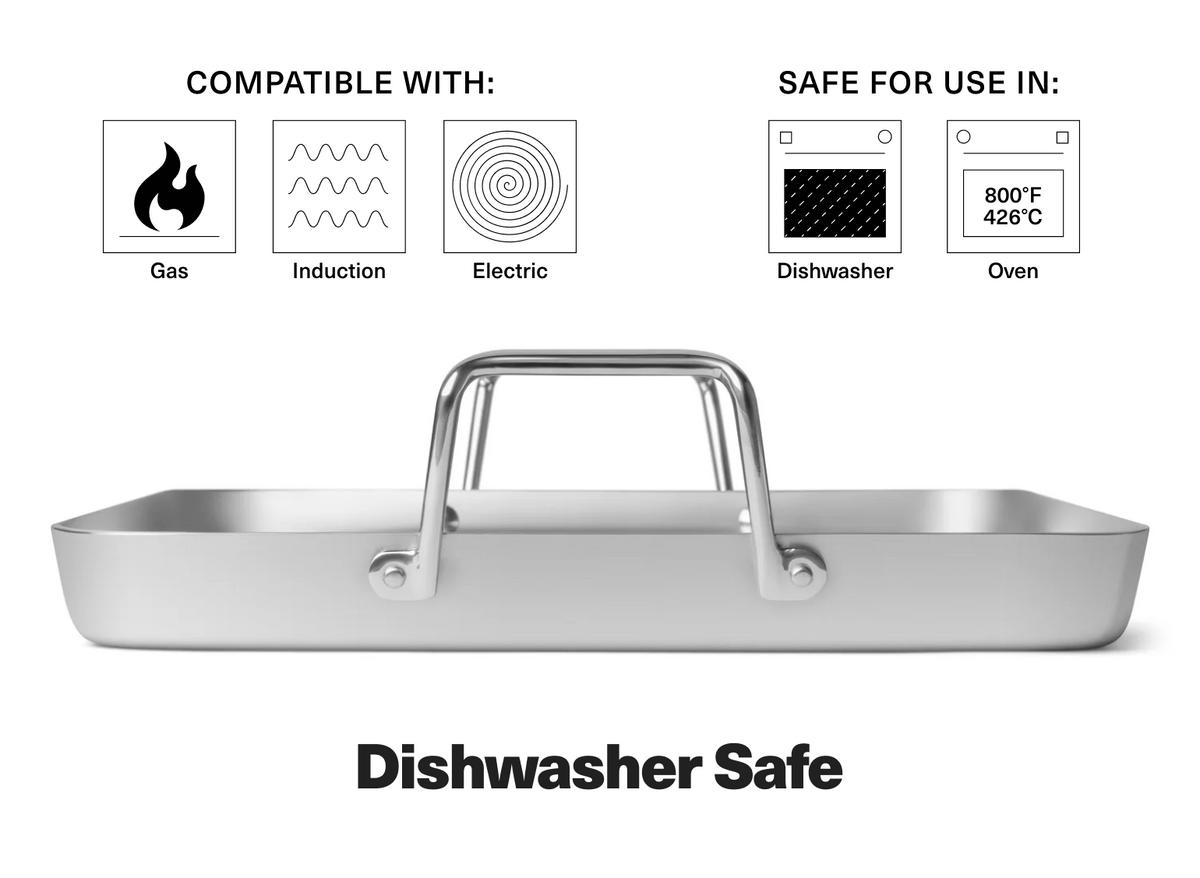Can a Stainless Steel Pan Go in the Oven?

Quality stainless steel pans are the Swiss-army-knife of cookware, moving effortlessly from stovetop to oven at temperatures up to 500-800°F—far hotter than non-stick—so you can sear a steak, finish it in the oven, and build a pan sauce in the same vessel without warping, off-flavors, or extra dishes. The article demystifies why construction matters: fully-clad, 18/10 tri-ply with riveted steel handles delivers even heat and lifetime durability, while thin or plastic-knobbed sets cap out around 400°F and risk failure. Readers learn to decode manufacturer stamps, spot red-flag materials, preheat correctly so food releases naturally, and avoid thermal-shock pitfalls like rinsing a 450°F pan with cold water. With these guidelines you’ll confidently roast acidic tomatoes, bake shakshuka, or broil a frittata, then restore the mirror finish with baking soda or Bar Keepers Friend, turning one pan into a lifetime passport to restaurant-quality techniques.
Introduction
Stainless steel pans are the home cook's secret weapon for seamlessly transitioning from stovetop to oven at high temperatures, unlocking restaurant-quality techniques while eliminating extra dishes and preserving flavors.
The Versatility Question: From Stovetop to Oven
Home cooks often face a common dilemma when following recipes that require starting dishes on the stovetop and finishing them in the oven. Stainless steel pans excel at this transition, handling temperatures that nonstick materials simply cannot withstand.
Unlike specialized cookware, they move seamlessly from burner to oven, even at high temperatures, creating opportunities for advanced cooking techniques [1]. While cast iron skillets can make this same journey, stainless steel offers more even heat distribution and weighs significantly less, making it easier to transfer between cooking surfaces [1].
This versatility eliminates the need for transferring food between different vessels, preserving flavors, reducing cleanup, and enabling restaurant techniques like perfectly seared then oven-finished proteins.
Common Concerns About Stainless Steel in High Heat
Many home cooks worry about damaging their stainless steel pans in the oven despite the material's reputation for durability. The most common concern is warping, particularly with thinner or lower-quality pans exposed to rapid temperature changes [3]. While pure stainless steel can withstand extreme heat, most cookware has specific oven-safe limits based on construction—we'll explore these temperature ranges in detail below.
These limits exist because of construction variables rather than the steel itself. Pans with non-stick coatings have lower temperature thresholds before the coating degrades and potentially releases harmful fumes [3]. Another overlooked issue is that lids often have lower heat tolerance than their corresponding pans, with glass lids being particularly vulnerable [3].
Even all-metal pans with riveted handles can be prone to warping if their design doesn't account for how different materials expand when heated [3]. This explains why some seemingly durable stainless steel sets are only rated oven-safe to 400°F—the same as non-stick pans with synthetic handles [3].
Why This Matters for Home Cooks and Recipe Execution
For home cooks, stainless steel's oven compatibility unlocks restaurant techniques that transform everyday meals. The ability to seamlessly move from stovetop to oven eliminates transferring food between vessels, preserving flavors while reducing cleanup [4]. This versatility proves crucial when executing recipes requiring temperature transitions—like perfectly seared meats that finish in the oven, or dishes that benefit from slow roasting after initial browning.
Stainless steel's non-reactive surface allows cooking acidic ingredients without flavor distortion, unlike cast iron or copper pans that might impart metallic tastes [4]. Additionally, stainless steel excels at developing fond—those caramelized bits that form the foundation of rich pan sauces—making it ideal for advanced cooking techniques requiring proper browning and deglazing [5]. When you invest in quality [stainless steel cookware](https://misen.
com/products/stainless-steel-skillet), you're getting a tool that handles temperature extremes, allowing for broiling, high-heat roasting, and other demanding applications [5]. This combination of versatility, durability and heat resistance empowers home cooks to execute complex recipes exactly as written, without compromising techniques or results.
Understanding Stainless Steel's Oven Compatibility
Check your pan's manual before sliding it into a 500°F oven—thickness, handle material, and chromium content (18% in quality Type 304 stainless) decide whether it emerges unscathed or warped.
The Short Answer: Yes, with Some Considerations
Yes, most stainless steel pans can go in the oven—but temperature limits vary widely. Quality cookware typically handles between 400°F and 800°F, with an industry average around 500°F [2]. Your pan's specific limit depends on several practical factors.
Thickness matters most (thinner pans warp more easily), followed by handle materials and any coatings applied to the cooking surface. If your pan has silicone-wrapped handles or non-stick coating, expect lower heat tolerance—usually maxing out around 500°F [2]. Here's a crucial tip: always check your manufacturer's documentation directly rather than trusting third-party retailers, which often list incorrect information [2].
Don't forget about lids—they frequently have different limits than their matching pans. Glass lids especially tend to max out at lower temperatures, and some aren't oven-safe at all [2].
What Makes Stainless Steel Heat-Resistant
What makes stainless steel so heat-resistant? It's all about chromium. This essential ingredient (at least 10. 5% in all stainless steel) creates an invisible protective layer when it meets oxygen [7].
Think of it as your pan's natural heat shield. The more chromium, the better the heat protection—basic stainless steel with 10. 5% chromium handles about 1,300°F, while higher grades with 18% chromium (like Type 304, found in quality cookware) remain stable up to 1,600°F [7]. That's way beyond any home oven temperature you'll ever need.
Other elements like silicon and aluminum boost this heat resistance even further [7]. This chemistry explains why a well-made [stainless steel pan](https://misen. com/products/stainless-steel-skillet) maintains its shape and performance through years of high-heat cooking—the protective layer keeps renewing itself every time you cook [6][7].
Temperature Thresholds for Different Quality Levels
Pan quality directly impacts your oven temperature limits. Premium 18/10 stainless steel (that's 18% chromium, 10% nickel) maintains its integrity at high temperatures [8]. You'll find this composition in 300-series cookware, particularly Type 304—the gold standard for heat resistance.
Budget-friendly 400-series pans (like 430 stainless) cost less but handle less heat and may show wear faster [8]. Here's what this means for your cooking: lower-grade pans typically max out at 350°F-400°F, while premium cookware safely handles 500°F or higher [8]. This difference really shows when you're broiling or searing—techniques where lesser pans might warp or discolor.
Professional chefs invest in quality construction specifically for seamless stovetop-to-oven transitions [8].
How Stainless Steel Compares to Other Oven-Safe Materials
How does stainless steel stack up against other oven-safe materials? Each has its sweet spot. Cast iron takes the crown for extreme heat—it laughs at temperatures up to 1500°F, making it unbeatable for broiling or campfire cooking [10]. But here's the trade-off: cast iron weighs a ton and holds heat so well it's hard to control temperature changes quickly.
Stainless steel strikes a practical balance—handling up to 500°F (or 800°F for premium versions) while staying light enough to maneuver easily from stovetop to oven [10]. The real advantage of stainless steel shows when you're cooking with acidic ingredients. Unlike bare cast iron, which can react with tomatoes or wine-based sauces, stainless steel's non-reactive surface keeps flavors pure [9]. Carbon steel offers a middle ground—nearly as heat-tolerant as cast iron (over 1,000°F) but lighter like stainless steel, perfect for roasting vegetables or baking bread [11].
Enameled Dutch ovens typically max out around 450-500°F, and hard-anodized aluminum usually stops at 400-500°F [11]. Your choice depends on your cooking style: pick stainless steel for versatility and quick temperature adjustments, cast iron for extreme heat retention, or carbon steel when you want the best of both worlds.
How to Determine If Your Specific Pan Is Oven-Safe
Flip your pan over and hunt for the oven-safe icon, because that tiny symbol—plus the handle material—decides whether your cookware can survive 375°F or 500°F without melting or warping.
Checking Manufacturer Specifications and Symbols
Your first step? Check what the manufacturer says. Look for markings on your pan's bottom, handles, or original packaging. You'll typically find a small oven icon, wavy heat lines, or straightforward text like "Oven Safe" or "Oven Proof" [13]. These symbols usually come with temperature ratings in both Fahrenheit and Celsius—pay attention to these numbers.
Here's something many home cooks miss: if your pan has special components like silicone-wrapped handles or glass lids, they'll have their own temperature limits. These parts often can't handle as much heat as the pan itself [12]. Glass lids especially tend to have lower limits than you'd expect. Can't find the markings anymore? Don't trust what third-party retailers say—they often get it wrong [12].
Head straight to the manufacturer's website or dig up that manual you stuffed in a drawer. When you buy new cookware, keep that documentation. It contains crucial temperature info that might not be stamped on the pan—most quality stainless steel pans handle between 350°F and 500°F [13].
Examining Handles, Rivets, and Other Components
Let's talk handles—they make or break your pan's oven safety. All-metal handles give you the highest heat tolerance, but watch out: hollow metal handles get scorching hot in the oven, even though they won't melt [15]. For the best combination of safety and durability, look for solid stainless steel handles attached with metal rivets [14]. Quality [stainless steel pan](https://misen. com/products/stainless-steel-skillet) models feature exactly this construction for worry-free oven use.
See plastic, wood, or silicone on your handle? That's your temperature ceiling right there—many plastic handles start melting around 400°F [15]. Those comfy silicone-wrapped handles might feel great on the stovetop, but they'll seriously limit your oven temperatures [14]. Here's what catches even experienced cooks off guard: premium brands sometimes have surprises. Le Creuset Dutch ovens come with plastic knobs that max out at 375°F, despite the pot itself handling much higher heat [14].
Always check where handles connect to the pan body. Plastic rivets? That's a red flag—they're notorious for failing at high temperatures [15]. Remember, your pan's only as oven-safe as its weakest component [15].
Red Flags That Indicate a Pan Isn't Oven-Safe
Here are the warning signs that scream "keep me out of the oven": First, check for plastic, wood, or silicone parts without clear heat-resistant labels [14]. These materials typically tap out around 350°F—and that's if you're lucky [16]. Even metal handles can be problematic if they're hollow, turning into burn hazards despite being technically heat-safe [16]. Look closely at how handles attach to your pan. Plastic rivets? Big problem.
They're infamous for failing when things heat up, potentially causing handles to detach mid-cooking [15]. No temperature rating on that nonstick coating? Proceed with extreme caution. Many nonstick surfaces start breaking down above 500°F, potentially releasing harmful chemicals [14]. Glass lids present another issue—they almost always have lower heat tolerance than their pans, and some shouldn't go in the oven at all [15]. Can't find any manufacturer info?
That's your biggest red flag. Without confirmed temperature ratings, you're gambling with warping, melting, or worse [16]. And if you spot any existing damage—loose handles, coating chips, warping—that pan stays out of the oven, period [15]. Mixed materials in one piece (like a metal pan with plastic-handled lid) mean you need to verify each component separately [15].
When to Trust (and When to Doubt) Unmarked Cookware
Got an unmarked pan? Don't panic—you can still make an educated guess. Start by assessing the quality. Does it have some heft to it? Substantial weight and solid construction usually mean better heat tolerance [8]. If you know the steel grade, that helps too.
Professional-grade 18/10 stainless steel (that's 18% chromium, 10% nickel) or 300-series steel like type 304 typically handles oven heat better than lighter 400-series options [8]. Handle construction tells a story—all-metal handles without any plastic, wood, or silicone usually mean higher temperature capability. Just remember that hollow metal handles get dangerously hot [12]. Want to test an unknown pan? Here's a simple method: place the empty pan in a cold oven, slowly raise the temperature to 350°F, and watch for warping, smoking, or weird smells [12]. If anything seems off, stop immediately.
When you're unsure, play it safe—stick to moderate temperatures (350-400°F) with unmarked stainless steel [8]. Thickness matters too. Heavier pans distribute heat better and resist warping, making them safer bets for oven use [12]. Watch for these deal-breakers: flimsy construction, any plastic parts, mystery non-stick coatings, or visible glue at connection points [12]. And those unmarked glass lids? Just remove them before oven use—they're almost always the weak link [8].
Best Practices for Using Stainless Steel Pans in the Oven
Master the 3-4-minute medium-high preheat until water beads skate across your stainless steel pan, choose tri-ply construction with riveted handles for oven temperatures, and always match burner size to pan diameter to prevent warping and ensure flawless stovetop-to-oven dishes.
Proper Preheating Techniques
Proper preheating prevents food from sticking to stainless steel pans when transitioning to oven cooking. Heat the empty pan on medium-high for 3-4 minutes before adding oil or food [17]. This simple step brings the pan to temperature while compressing steel's natural pores to reduce sticking [17].
To test readiness, use the water drop method: add a drop of water to the heated pan—if it puddles and boils away, continue heating [17]. When the water forms round balls that bounce across the surface, your pan has reached ideal temperature [17]. Always set a timer during preheating for fire safety [17].
This technique creates the perfect foundation for dishes that start on the stovetop and finish in the oven, improving food release and flavor development.
Safe Temperature Ranges for Different Pan Constructions
Different stainless steel pan constructions have varying oven-safe temperature thresholds. Tri-ply and multi-ply constructions provide superior heat distribution and structural integrity at high temperatures compared to single-ply options [18]. The layered construction of these pans (typically stainless steel with an aluminum or copper core) resists warping that can occur during thermal shock. Handle construction significantly impacts temperature limitations—thick, solid stainless steel handles conduct heat slowly but remain oven-safe at high temperatures, while side handles heat faster than long handles due to their proximity to the pan body [19].
For optimal safety, ensure your cooking element doesn't exceed the pan's diameter, as oversized heat sources contribute to handle overheating and potential warping [19]. Pan thickness plays a crucial role in heat tolerance; thicker, higher-quality pans resist the warping that typically occurs from thermal shock (overheated empty pans or hot pans contacting cold surfaces) [19]. When using stainless steel in the oven, always use oven mitts as all handle types eventually become hot during extended oven exposure [19]. For maximum oven performance, select pans with securely riveted handles, as repeated heating and cooling cycles can cause fasteners to loosen over time [19].
Quality tri-ply construction, like this [stainless steel pan](https://misen. com/products/stainless-steel-skillet), combines these features for reliable stovetop-to-oven versatility.
Handling Hot Stainless Steel Safely
Handling hot stainless steel pans requires specific safety measures to prevent burns. Always use heat-resistant gloves or mitts that are completely dry—wet mitts conduct heat quickly, negating their protective properties [20]. When removing pans from the oven, grip them firmly with both hands to ensure stability, particularly for heavier multi-ply cookware [22]. Remember that stainless steel handles, especially hollow ones, become extremely hot in ovens and retain heat longer than other materials [22].
Establish clear verbal warnings like "Hot pan coming through! " when moving cookware in shared kitchens [20]. For transitioning pans between cooking surfaces, use dedicated heat-resistant resting areas rather than placing hot pans directly on countertops [22]. If a burn occurs despite precautions, immediately run the affected area under cool water for at least 20 minutes and seek medical attention if needed [21].
Stainless steel retains heat efficiently, so allow pans to cool naturally before handling without protection or cleaning [22]. This cooling period helps prevent both burns and potential warping from thermal shock.
Preventing Warping and Maintaining Pan Integrity
Prevent warping by understanding its underlying cause: thermal expansion. When a stainless steel pan heats, the flat bottom expands more than the raised edges, creating tension that forces the pan to bend or buckle. This warping becomes dangerous when it happens suddenly, potentially flinging hot food and causing burns [23].
Pan thickness directly impacts warping resistance—standard 18-gauge stainless steel pans offer moderate protection, but professional 12-gauge versions provide superior stability at high temperatures [23]. The design also matters significantly; pans with fewer raised edges warp less because they create less resistance to thermal expansion [23]. To maximize pan integrity, allow for gradual temperature changes rather than shocking the metal.
Preheat your pan with the oven rather than placing a cold pan into a hot environment, and let it cool naturally on a heat-resistant surface after cooking. For dishes requiring long roasting times (30+ minutes) at temperatures above 400°F, invest in heavier-gauge stainless steel that can handle the prolonged heat stress [23]. When selecting new cookware, remember that full-size professional sheet pans (18"x26") typically won't fit in standard home ovens [23].
Cooking Techniques That Showcase Stainless Steel's Versatility
Master the sear-and-finish method—preheat your stainless steel pan until water droplets dance, add high-smoke-point oil, sear proteins until they release naturally, then slide the whole pan into the oven to finish cooking while those browned bits become restaurant-worthy pan sauces.
Sear-And-Finish Method for Restaurant-Quality Results
The sear-and-finish method transforms your stainless steel pan into a powerhouse cooking tool that rivals restaurant kitchens. Here's how it works: you'll start by searing on the stovetop, then smoothly transfer to the oven for perfect results every time. The secret lies in understanding your pan's unique surface—when properly preheated, those microscopic pores create an almost magical non-stick effect through something called the Leidenfrost Effect [26]. Start by preheating your empty [stainless steel pan](https://misen. com/products/stainless-steel-skillet) for 5-7 minutes. You'll know it's ready when water droplets dance across the surface rather than immediately evaporating [26].
Only then should you add oil—this timing is crucial for preventing sticking. When searing proteins, patience pays off. Let that crust develop fully before attempting to flip—your food will actually tell you when it's ready by releasing naturally, usually after 3-5 minutes for steaks [26]. Those beautiful brown bits left behind? That's fond, your ticket to incredible pan sauces [24]. Simply transfer the whole pan to your preheated oven to finish cooking, keeping all those flavors intact.
This technique shines because stainless steel handles temperature transitions like a champ, distributing heat evenly while moving seamlessly from burner to oven [25]. After deglazing with wine or stock, you'll dissolve all that flavorful fond into restaurant-worthy sauces that simply aren't possible with non-stick cookware [24]. Pro tip: Skip the olive oil for high-heat searing. Instead, reach for avocado oil (520°F smoke point) or refined safflower oil (510°F) to avoid smoking up your kitchen [25].
Dishes That Benefit from Stovetop-To-Oven Cooking
Ready to put this technique into practice? Here are dishes that truly shine with stovetop-to-oven cooking: **Thick-cut proteins** like ribeye steaks and double-cut pork chops get the best of both worlds—a gorgeous crust from stovetop searing followed by gentle, even cooking in the oven that keeps them perfectly juicy [27]. **Pan-seared salmon** becomes foolproof with this method. Get that skin crispy on the stovetop, then let the oven gently finish cooking the delicate flesh without risk of overcooking [29].
**One-dish pasta recipes** save time and dishes. Build your flavor base on the stovetop—sautéing garlic, adding tomatoes—then pop the whole pan in the oven to let everything meld while the pasta cooks to perfection [27]. **Global favorites** like chili lime snapper showcase your pan's versatility. The initial stovetop fry creates that golden crust, while oven finishing allows spices to infuse deeply [28].
Similarly, butter chicken develops incredible depth when you brown the aromatics first, then let the oven work its slow magic on the tomato-coconut sauce [28]. **Shakshuka** practically demands this technique—build your spiced tomato base on the stovetop, nestle in the eggs, then finish in the oven for perfectly set whites and runny yolks [28]. Notice the pattern? Each dish benefits from the seamless transition, keeping all those developed flavors in one pan while cutting down on cleanup.
When to Choose Stainless Steel Over Cast Iron or Dutch Ovens
Choosing the right cookware for stovetop-to-oven cooking isn't always straightforward. Here's when stainless steel is your best bet: **Working with acidic ingredients? ** Reach for stainless steel. Those tomato sauces, wine reductions, and citrus marinades that could strip cast iron's seasoning and add unwanted metallic flavors? Your stainless steel pan handles them without breaking a sweat [30]. **Need precise temperature control? ** Stainless steel responds quickly to heat changes, making it ideal for delicate fish fillets or cream sauces that could curdle with cast iron's intense heat retention [30].
Plus, its lighter weight means you can actually lift it with one hand when transferring from stovetop to oven—try that with a loaded cast iron skillet! [30] That said, cast iron has its place. Nothing beats it for ultra-high-heat searing or baking cornbread with that signature crust [30]. And Dutch ovens? They're moisture-retention champions for braises and stews, though their typical 350-450°F limits and hefty weight make them less versatile for quick stovetop-to-oven techniques [31]. The bottom line: let your recipe guide you. Cooking something acidic or delicate that needs temperature finesse?
Stainless steel. Want maximum heat retention for a thick steak? Cast iron wins. Planning a long, slow braise? That's Dutch oven territory [31].
Chef-Approved Tips for Perfect Results
Want to cook like a pro? These chef-tested tips will transform your stainless steel cooking: **Master the release. ** Here's what's happening: as your pan heats, those microscopic pores shrink. When you add food, the temperature drops slightly and the pan grips it. But wait—once the pan reheats, it'll release your food naturally [32]. Fighting this process only tears your beautiful crust, so patience is key. **The water test never lies.
** Preheat your pan on medium heat, then sprinkle in a few water drops. If they sizzle and evaporate immediately, you're ready to cook [33]. Only now should you add oil—let it shimmer before adding ingredients [33]. **Embrace the fond. ** Those brown bits stuck to your pan after searing? That's liquid gold. Stainless steel's surface actually pinches tiny food particles, creating incredible flavor foundations [32].
Deglaze with wine or stock, scrape up those bits, and watch them transform into restaurant-quality sauces [32]. **Stop stirring! ** Constant movement prevents proper browning. Let proteins develop their crust undisturbed. Let vegetables actually caramelize. Your patience will be rewarded with deeper, more complex flavors that elevate everyday ingredients [33]. Remember: great cooking isn't about fancy techniques—it's about understanding your tools and working with them, not against them.
Maintaining Your Stainless Steel After Oven Use
Protect your stainless steel from warping by letting it cool naturally, using room-temperature liquids for deglazing, and cleaning with hot—not cold—water while the pan's still warm.
Proper Cooling Procedures to Prevent Warping
Thermal shock—sudden temperature changes—is what causes warping in stainless steel. Never run a hot pan under cold water, as this forces the metal to contract unevenly [34]. Let your pan cool naturally on the stovetop until you can touch the bottom comfortably [35].
This gradual cooling helps the metal maintain its shape. When deglazing, use room temperature liquids, not cold ingredients from the fridge [35]. Pour from the edges, not the center, to avoid creating hot and cold spots [35].
If your pan has food in it, empty it while hot—but don't immediately rinse or soak. Even warm water can cause thermal shock [35]. This cooling routine matters most for thinner pans, which warp more easily than heavier cookware [35].
Cleaning Methods That Preserve Appearance and Function
Daily cleaning starts while your pan is still hot. Scrape out oil with a spatula, then deglaze with hot water—cold water will warp your pan [36]. Use a long-handled brush to loosen food bits, then scrub with a scouring pad and dish soap in circular motions [36].
For tough stains from high-heat cooking, you have two effective options: baking soda for light discoloration, or Bar Keepers Friend for stubborn marks [36]. Got burnt spots climbing the sides? Add ¼ cup water to a mound of baking soda in your pan and bring to a boil [36].
As the water evaporates, it creates a baking soda film you can scrub off while warm [36]. For deep cleaning years of buildup, submerge your pan in a larger pot of boiling water with ¼ to ½ cup baking soda for 15-30 minutes [36].
Addressing Discoloration from High Heat Exposure
Those yellow or rainbow colors on your pan? That's chromium oxide forming when the steel meets high heat and oxygen [37]. It looks concerning but won't affect your cooking or food safety—it's purely cosmetic [37].
To restore your pan's original look, Bar Keepers Friend works best for removing discoloration without scratching [37]. You can also make a baking soda paste (skip the vinegar—it cancels out the cleaning power) or spray Dawn Powerwash and let it sit for 15-30 minutes before scrubbing [37]. Some discoloration is normal.
Regular searing and sautéing creates the same effect over time, just more slowly than overheating an empty pan [37]. This tinting is actually extra chromium oxide—the same stuff that makes stainless steel resist corrosion—so it's completely harmless [37].
Extending the Lifespan of Your Oven-Used Cookware
To keep your cookware performing well for years, let pans cool gradually before washing—cold water on hot steel causes warping [38]. Clean with mild dish soap and soft sponges, not harsh chemicals or abrasive scrubbers [38]. While stainless steel loves high heat, don't push it to maximum temperatures for extended periods—this speeds up wear [38].
Try seasoning your pan like cast iron: heat it with a thin oil layer to build a natural non-stick surface [38]. Store smart by using cloth protectors between stacked pans or hanging them up [38]. If you're constantly moving pans from stovetop to oven, stick with silicone or wooden utensils—metal tools scratch the surface over time [38].
These simple habits keep your stainless steel looking good and cooking great for decades.
Conclusion
Key Takeaways About Stainless Steel Pans in the Oven
You've learned that most stainless steel pans handle oven temperatures between 400°F and 800°F, though the average is around 500°F [39]. As we covered throughout this guide, your pan's construction makes all the difference—all-metal handles give you the highest heat tolerance, while non-stick coatings or silicone parts limit you to 400-500°F [39]. Remember to always verify your specific pan's limits with the manufacturer directly, not third-party sellers who often get it wrong [39].
The key safety factors we've discussed—from handle materials to lid compatibility—help you cook confidently. Glass lids especially need attention since they often can't handle the same heat as the pan itself [39]. Stainless steel gives you advantages we explored earlier: easier handling than cast iron, no reactions with acidic foods, and even heating when properly constructed [39].
Keep your pans in great shape by avoiding temperature shocks, using dry oven mitts every time, and letting everything cool naturally before cleaning [39].
Making Informed Decisions for Your Cooking Needs
When you're ready to choose stainless steel cookware for oven use, focus on construction first. Fully clad pans—where metals are layered throughout—prevent those frustrating hot spots and give you stainless steel's durability with aluminum's even heating [41]. Tri-ply construction particularly excels at distributing heat whether you're on the stovetop or in the oven [40]. For dependable oven performance, look for pans with riveted stainless steel handles that can take the heat [41].
You'll know quality cookware by its weight—it should feel substantial, not flimsy [41]. Before buying, check that pans sit flat without wobbling and that handles are securely attached [41]. While premium brands set the standard, you'll find excellent performance at more accessible price points too [40][41]. Think about how you actually cook—if you love searing steaks then finishing them in the oven, a [12-inch stainless steel pan](https://misen.
com/products/stainless-steel-skillet) gives you the room you need for proper browning [40]. Electric stovetop users should prioritize heavy-bottomed pans to prevent warping and maintain even contact with heating elements [40].
Investing in Quality for Versatile, Long-Lasting Cookware
Quality stainless steel cookware truly is an investment that serves you for decades. The best pans use multi-layered construction—tri-ply with an aluminum core or five-ply for even better heat distribution [42]. This smart design eliminates those annoying hot spots that burn your food in some areas while leaving it undercooked in others. When you're evaluating quality, feel the weight—good pans have substance without being too heavy to handle comfortably.
They should sit perfectly flat and have handles that feel rock-solid [44]. Yes, premium sets can cost $600-1,000, but you'll find excellent performance in the $250-300 range too [43]. What makes quality stainless steel worth it? These pans move effortlessly from stovetop to oven at temperatures up to 500°F or higher [42].
Fully-clad construction beats disc-bottom designs because heat travels evenly up the sides—crucial when you're making sauces or dishes that need consistent temperature throughout [44]. Beyond price, think about daily use: comfortable handles that stay cooler, lids that seal properly, and balanced weight that won't tire you out [43]. Unlike nonstick pans that need replacing every few years, quality stainless steel becomes your kitchen companion for life—making it a smart culinary investment, not just another purchase [42].
- Most stainless steel pans are oven-safe from 400-800°F, average 500°F
- All-metal handles give highest heat tolerance; plastic/silicone caps at ~400°F
- Thicker, fully-clad tri-ply pans resist warping and heat evenly
- Glass lids often have lower limits; check separate from pan rating
- Avoid thermal shock: let pan cool naturally before rinsing
- Preheat empty pan 3-4 min until water droplets dance to prevent sticking
- Deglaze fond while pan is hot for restaurant-quality pan sauces
- https://www.foodandwine.com/guide-to-stainless-steel-cookware-8558171
- https://prudentreviews.com/stainless-steel-cookware-oven-safe/
- https://www.reddit.com/r/Cooking/comments/11yt6mj/why_is_some_stainless_steel_cookware_not_oven/
- https://housewifehowtos.com/cook/how-to-cook-with-stainless-steel/
- https://www.dioro.com/blogs/news/cooking-with-stainless-steel?srsltid=AfmBOor5JdooYTQ15lV7nBnONcwMADGk57GbaFs0wnLEXwMKftcUzFLy
- https://www.xometry.com/resources/materials/18-10-stainless-steel/
- https://en.wikipedia.org/wiki/Stainless_steel
- https://www.thekitchn.com/stainless-steel-in-oven-23705483
- https://stahlkitchens.com/blogs/news/oven-safe-cookware?srsltid=AfmBOopjaFxW1-VDzNj7MwIRdmK5JRHOP_vR-nW9VYGwi-jKgqr72hEo
- https://madeincookware.ca/blogs/news/cast-iron-vs-stainless-steel-what-s-the-difference
- https://creators.yahoo.com/lifestyle/story/this-is-how-to-tell-if-your-cookware-is-oven-safe-151930253.html
- https://smart.dhgate.com/how-to-confidently-identify-oven-safe-pans-and-avoid-kitchen-mishaps/
- https://www.solamexhome.com/the-complete-guide-to-oven-safe-pots-everything-you-need-to-know.html
- https://www.allrecipes.com/article/is-my-cookware-really-oven-safe/
- https://www.solamexhome.com/oven-safe-cookware-guide-safety-brands-mistakes-to-avoid.html
- https://smart.dhgate.com/how-to-safely-determine-if-your-pan-can-go-in-the-oven/
- https://misen.com/pages/stainless-care?srsltid=AfmBOop4fJXUhyvtnTIIUXxB_J4h4y63CoA0e3Gsn4mlrNTA4fj7vQ9d
- https://www.boroughkitchen.com/blogs/news/a-guide-to-stainless-steel-pots-pans
- https://www.t-fal.com/pro-tri-ply-stainless-steel-13-piece-cookware-set-silver.html?srsltid=AfmBOoq92B2j7GvYBiXPwFoWLb4SjIljzSbx4pjGsAePjRxD-ylxDuYZ
- https://www.wfa.edu.sg/blog/How-To-Keep-Hot-Surfaces-Safe-In-A-Busy-Commercial-Kitchen
- https://vinodcookware.com/blogs/articles/cookware-and-kitchen-safety-7-tips-for-preventing-accidents-and-injuries-in-the-kitchen?srsltid=AfmBOopWHla004D38FEo75LxwY1OGWTonjbHHTQxmS-csxRdYlO_FaM9
- https://leadingcatering.com.au/blog/post/what-are-some-safety-tips-when-using-high-temperature-commercial-catering-equipment?srsltid=AfmBOor0Wcj64Xl-HGbqStnmmlzkppSTp4UiOIr51OyS0zqM42fgnU2h
- https://cooking.stackexchange.com/questions/103899/preventing-warping-when-roasting-at-high-temperature
- https://www.heritagesteel.us/pages/cooking-techniques?srsltid=AfmBOopu0whGyClv8nTsrVkfZhqY__i56eTXRw-2D84ZRT16zlwB5gol
- https://www.dioro.com/blogs/news/steak-in-stainless-steel-pan?srsltid=AfmBOops20PYmTbfd0xHbsf6iX-13IsAomrgz1qxxOFp1qIj4iaEUqx6
- https://theintrepidgourmet.com/2019/01/21/how-to-cook-with-stainless-steel/
- https://www.tasteofhome.com/article/how-to-cook-with-stainless-steel/
- https://www.lecreuset.ca/en_CA/blog/8-recipes-for-every-piece-of-ss-cookware.html?srsltid=AfmBOooLk0bIQpK9yBVS64BIbYnxiDKIpl_yOk13GCtjMYV6rAajWxTy
- https://www.buymeonce.co.uk/blogs/research/10-delicious-things-to-cook-in-your-stainless-steel-frying-pan?srsltid=AfmBOoogA6mbA02-7QYa4uXJTEbfxitf1rGh8LiizAAT8Jy0Lffya6qK
- https://www.reddit.com/r/Cooking/comments/9j3q1h/question_when_to_use_stainless_steel_vs_cast_iron/
- https://www.quora.com/What-are-the-benefits-of-using-stainless-steel-or-cast-iron-Dutch-ovens-skillets
- https://www.heritagesteel.us/pages/cooking-techniques?srsltid=AfmBOopeO4qhM8J_lB99ccpGFpJV-kEu7PFhZ5nBiuscZXMJ1uraedVO
- https://www.blackmoorhome.co.uk/blog/mastering-the-art-of-cooking-with-stainless-steel-cookware/
- https://www.marthastewart.com/7617742/how-care-stainless-steel-pan-prevent-burning-warping
- https://cooking.stackexchange.com/questions/14669/bowed-bottom-on-stainless-steel-fry-pan
- https://www.nytimes.com/wirecutter/guides/how-to-clean-stainless-steel-pans/
- https://www.reddit.com/r/Cooking/comments/17zrk3a/restore_overheated_and_discolored_stainless_steel/
- https://www.zhenneng.com/a-news-6-maintenance-details-to-extend-the-life-of-stainless-steel-cookware.html
- https://misen.com/blogs/news/oven-safe-skillet?srsltid=AfmBOopPwQ9jgeTHWXynRxAwBlmqqhedX9cG3_YhoSm0JSz5NIOy58fk
- https://www.reddit.com/r/Cooking/comments/bb76zl/what_to_look_out_for_when_buying_a_stainless/
- https://guide.michelin.com/us/en/article/features/stainless-steel-cookware-purchasing-guide
- https://www.consumerreports.org/home-garden/cookware/buying-guide/
- https://www.foodandwine.com/lifestyle/kitchen/best-stainless-steel-cookware-sets
- https://www.eater.com/24427087/made-in-vs-all-clad-stainless-steel-cookware
